Assessment of Non-Consumptive Predation Risk of Coccinella septempunctata (Coleoptera: Coccinellidae) on the Population Growth of Sitobion miscanthi (Hemiptera: Aphididae)
Abstract
:Simple Summary
Abstract
1. Introduction
2. Materials and Methods
2.1. Collection and Maintenance of Insects
2.2. Experimental Design and Life Table Study
2.3. Life Table Analysis
3. Results
3.1. Nymphal Development
3.2. Adult Longevity, Reproduction, and the Percent of Winged Morphs
3.3. Life Table and Population Parameters
3.4. Population Projection of S. miscanthi
4. Discussion
5. Conclusions
Author Contributions
Funding
Institutional Review Board Statement
Informed Consent Statement
Data Availability Statement
Acknowledgments
Conflicts of Interest
References
- Frank, D.A. Evidence for top predator control of a grazing ecosystem. Oikos 2008, 117, 1718–1724. [Google Scholar] [CrossRef]
- Hawlena, D.; Schmitz, O.J. Herbivore physiological response to predation risk and implications for ecosystem nutrient dynamics. Proc. Natl. Acad. Sci. USA 2010, 107, 15503–15507. [Google Scholar] [CrossRef] [Green Version]
- Sih, A. Antipredator responses and the perception of danger by mosquito larvae. Ecology 1986, 67, 434–441. [Google Scholar] [CrossRef]
- Turner, A.M.; Bernot, R.J.; Boes, C.M. Chemical cues modify species interactions: The ecological consequences of predator avoidance by freshwater snails. Oikos 2000, 88, 148–158. [Google Scholar] [CrossRef]
- Ingerslew, K.S.; Finke, D.L. Non-consumptive effects stabilize herbivore control over multiple generations. PLoS ONE 2020, 15, e0241870. [Google Scholar] [CrossRef]
- Fan, J.; Zhang, Y.; Francis, F.; Cheng, D.; Sun, J.; Chen, J. Orco mediates olfactory behaviors and winged morph differentiation induced by alarm pheromone in the grain aphid, Sitobion avenae. Insect Biochem. Mol. Biol. 2015, 64, 16–24. [Google Scholar] [CrossRef] [PubMed] [Green Version]
- Peacor, S.D.; Peckarsky, B.L.; Trussell, G.C.; Vonesh, J. Costs of predator-induced phenotypic plasticity: A graphical model for predicting the contribution of nonconsumptive and consumptive effects of predators on prey. Oecologia 2013, 171, 1–10. [Google Scholar] [CrossRef]
- Sheriff, M.J.; Thaler, J.S. Ecophysiological effects of predation risk; an integration across disciplines. Oecologia 2014, 176, 607–611. [Google Scholar] [CrossRef] [Green Version]
- Preisser, E.L.; Bolnick, D.I.; Benard, M.F. Scared to death? The effects of intimidation and consumption in predator–prey interactions. Ecology 2005, 86, 501–509. [Google Scholar] [CrossRef] [Green Version]
- Hajek, A.E. Natural Enemies: An Introduction to Biological Control; Cambridge University Press: Cambridge, UK, 2004. [Google Scholar]
- Wilson, M.R.; Leather, S.R. The effect of past natural enemy activity on host-plant preference of two aphid species. Entomol. Exp. Appl. 2012, 144, 216–222. [Google Scholar] [CrossRef]
- Lagrue, C.; Besson, A.A.; Lecerf, A. Interspecific differences in antipredator strategies determine the strength of non-consumptive predator effects on stream detritivores. Oikos 2015, 124, 1589–1596. [Google Scholar] [CrossRef]
- Rypstra, A.L.; Buddle, C. Spider silk reduces insect herbivory. Biol. Lett. 2013, 9, 20120948. [Google Scholar] [CrossRef] [Green Version]
- Wasserberg, G.; White, L.; Bullard, A.; King, J.; Maxwell, R. Oviposition site selection in Aedes albopictus (Diptera: Culicidae): Are the effects of predation risk and food level independent? J. Med. Entomol. 2013, 50, 1159–1164. [Google Scholar] [CrossRef] [PubMed] [Green Version]
- Sendoya, F.; Freitas, V.L.; Oliveira, P.S. Egg-laying butterflies distinguish predaceous ants by sight. Am. Nat. 2015, 174, 134–140. [Google Scholar] [CrossRef]
- Bucher, R.; Menzel, F.; Entling, M.H. Risk of spider predation alters food web structure and reduces local herbivory in the field. Oecologia 2015, 178, 571–577. [Google Scholar] [CrossRef] [PubMed]
- Xiong, X.; Michaud, J.P.; Li, Z.; Wu, P.; Chu, Y.; Zhang, Q.; Liu, X. Chronic, predator-induced stress alters development and reproductive performance of the cotton bollworm, Helicoverpa armigera. BioControl 2015, 60, 827–837. [Google Scholar] [CrossRef]
- Thaler, J.S.; Contreras, H.; Davidowitz, G. Effects of predation risk and plant resistance on Manduca sexta caterpillar feeding behaviour and physiology. Ecol. Entomol. 2014, 39, 210–216. [Google Scholar] [CrossRef]
- Pauwels, K.; Stoks, R.; De Meester, L. Coping with predator stress: Interclonal differences in induction of heat-shock proteins in the water flea Daphnia magna. J. Evol. Biol. 2005, 18, 867–872. [Google Scholar] [CrossRef]
- Kersch-Becker, M.F.; Thaler, J.S. Plant resistance reduces the strength of consumptive and non-consumptive effects of predators on aphids. J. Anim. Ecol. 2015, 84, 1222–1232. [Google Scholar] [CrossRef]
- Ninkovic, V.; Feng, Y.; Olsson, U.; Pettersson, J. Ladybird footprints induce aphid avoidance behavior. Biol. Control 2013, 65, 63–71. [Google Scholar] [CrossRef] [Green Version]
- Venkanna, Y.; Suroshe, S.S.; Dahuja, A. Non-consumptive effects of the zigzag ladybird beetle, Cheilomenes sexmaculata (Fab.) on its prey, the cotton aphid, Aphis gossypii Glover. Biocontrol Sci. Technol. 2021, 31, 1204–1219. [Google Scholar] [CrossRef]
- Jiang, X.; Zhang, Q.; Qin, Y.; Yin, H.; Zhang, S.; Li, Q.; Zhang, Y.; Fan, J.; Chen, J. A chromosome-level draft genome of the grain aphid Sitobion miscanthi. GigaScience 2019, 8. [Google Scholar] [CrossRef] [Green Version]
- Li, D.; Su, D.; Tong, Z.; Zhang, C.; Zhang, G.; Zhao, H.; Hu, Z. Virus-dependent and -independent responses of Sitobion avenae (Hemiptera: Aphididae) feeding on wheat infected by transmitted and nontransmitted viruses at transcriptomic level. J. Econ. Entomol. 2019, 112, 2067–2076. [Google Scholar] [CrossRef]
- Luo, C.; Monticelli, L.S.; Li, D.; Ahmed, S.S.; Pandharikar, G.; Zhao, H.; Desneux, N.; Hu, Z. Comparison of life-history traits and resistance for Sitobion avenae (Fabricius) harboring a facultative symbiont. Entomol. Gen. 2020, 40, 39–47. [Google Scholar] [CrossRef]
- Hu, Z.; Su, D.; Li, D.; Tong, Z.; Zhang, C.; Zhang, G.; Zhao, H.; Luo, C. Diversity of secondary endosymbionts among different geographical populations of the grain aphid, Sitobion avenae (Fabricius) (Hemiptera:Aphididae) in China. Entomol. Gen. 2020, 40, 253–262. [Google Scholar] [CrossRef]
- Luo, C.; Chai, R.; Liu, X.; Dong, Y.; Desneux, N.; Feng, Y.; Hu, Z. The facultative symbiont Regiella insecticola modulates non-consumptive and consumptive effects of Harmonia axyridis on host aphids. Entomol. Gen. 2022. [Google Scholar] [CrossRef]
- Krengel, S.; Richter, C.; Freier, B.; Stangl, G.I.; Brandsch, C. The effect of elevated temperatures on food conversion ef-ficiencies of Coccinella septempunctata and Harmonia axyridis young adults feeding on Sitobion avenae. J. Plant. Dis. Prot. 2013, 120, 218–226. [Google Scholar] [CrossRef]
- Chen, F.J.; Gang, W.; Parajulee, M.N.; Feng, G. Impact of elevated CO2 on the third trophic level: A predator Harmonia axyridis and a parasitoid Aphidius picipes. Biocontrol. Sci. Techn. 2007, 17, 313–324. [Google Scholar] [CrossRef]
- Stark, J.D.; Banks, J.E. Population-level effects of pesticides and other toxicants on arthropods. Annu. Rev. Entomol. 2003, 48, 505–519. [Google Scholar] [CrossRef] [PubMed]
- Guedes, R.N.C.; Smagghe, G.; Stark, J.D.; Desneux, N. Pesticide-induced stress in arthropod pests for optimized integrated pest management programs. Annu. Rev. Entomol. 2016, 61, 43–62. [Google Scholar] [CrossRef] [Green Version]
- Chi, H.; Liu, H. Two new methods for the study of insect population ecology. Bull. Inst. Zool. Acad. Sinica. 1985, 24, 225–240. [Google Scholar]
- Chi, H. Life-table analysis incorporating both sexes and variable development rates among individuals. Environ. Entomol. 1988, 17, 26–34. [Google Scholar] [CrossRef]
- Chi, H.; You, M.S.; Atlihan, R.; Smith, C.L.; Kavousi, A.; Özgökçe, M.S.; Güncan, A.; Tuan, S.; Fu, J.; Xu, Y.; et al. Age-Stage, two-sex life table: An introduction to theory, data analysis, and application. Entomol. Gen. 2020, 40, 103–124. [Google Scholar] [CrossRef]
- Ramírez-Cáceres, G.E.; Moya-Hernández, M.G.; Quilodrán, M.; Nespolo, R.F.; Ramírez, C.C. Harbouring the secondary endosymbiont Regiella insecticola increases predation risk and reproduction in the cereal aphid Sitobion avenae. J. Pest. Sci. 2019, 92, 1039–1047. [Google Scholar] [CrossRef]
- Yu, X.L.; Tang, R.; Xia, P.L.; Wang, B.; Feng, Y.; Liu, T.X. Effects of prey distribution and heterospecific interactions on the functional response of Harmonia axyridis and Aphidius gifuensis to Myzus persicae. Insects 2020, 11, 325. [Google Scholar] [CrossRef] [PubMed]
- Chi, H. TWOSEX-MSChart: A Computer Program for the Age-Stage, Two-Sex Life Table Analysis; National Chung Hsing University: Taichung, Taiwan, 2020; Available online: http://140.120.197.173/Ecology/prod02.htm (accessed on 13 May 2020).
- Chang, C.; Huang, Y.C.; Dai, S.M.; Atlihan, R.; Chi, H. Genetically engineered ricin suppresses Bactrocera dorsalis (Diptera: Tephritidae) based on demographic analysis of group-reared lifetable. J. Econ. Entomol. 2016, 109, 987–992. [Google Scholar] [CrossRef] [PubMed] [Green Version]
- Chi, H.; Su, H.-Y. Age-stage, two-sex life tables of Aphidius gifuensis(Ashmead) (Hymenoptera: Braconidae) and its host Myzus persicae(Sulzer) (Homoptera: Aphididae) with mathematical proof of the relationship between female fecundity and the net reproductive rate. Environ. Entomol. 2006, 35, 10–21. [Google Scholar] [CrossRef]
- Cook, L. The genetical theory of natural selection: A complete variorum edition. Heredity 2000, 84, 390–391. [Google Scholar] [CrossRef]
- Huang, Y.B.; Chi, H. The age-stage, two sex life table with an offspring sex ratio dependent on female age. J. Agri. Fore. 2011, 60, 337–345. Available online: https://www.researchgate.net/publication/265661520_The_Age-Stage_Two-Sex_Life_Table_with_an_Offspring_Sex_Ratio_Dependent_on_Female_Age (accessed on 2 January 2022).
- Tuan, S.J.; Lee, C.C.; Chi, H. Population and damage projection of Spodoptera litura (F.) on peanuts (Arachis hypogaea L.) under different conditions using the age-stage, two-sex life table. Pest. Manag. Sci. 2014, 70, 805–813. [Google Scholar] [CrossRef] [PubMed]
- Tuan, S.J.; Lee, C.C.; Chi, H. Population and damage projection of Spodoptera litura (F.) on peanuts (Arachis hypogaea L.) under different conditions using the age-stage, two-sex life table. Pest. Manag. Sci. 2014, 70, 1936, Erratum. [Google Scholar] [CrossRef]
- Tuan, S.J.; Yeh, C.C.; Atlihan, R.; Chi, H.; Tang, L.C. Demography and consumption of Spodoptera literal(Lepidoptera: Noctuidae) reared on cabbage and Taro. J. Econ. Entomol. 2015, 109, 732–739. [Google Scholar] [CrossRef]
- Efron, B.; Tibshirani, R.J. An introduction to the bootstrap. Chapman & Hall: New York, NY, USA, 1993; Available online: https://onlinelibrary.wiley.com/doi/pdf/10.1111/1467-9639.00050 (accessed on 2 January 2022).
- Akköprü, E.P.; Atlıhan, R.; Okut, H.; Chi, H. Demographic assessment of plant cultivar resistance to insect pests: A case study of the dusky-veined walnut aphid (Hemiptera: Callaphididae) on five walnut cultivars. J. Econ. Entomol. 2015, 108, 378–387. [Google Scholar] [CrossRef]
- Brandstätter, E. Confidence intervals as an alternative to significance testing. Methods. Psychol. Res. 1999, 4, 33–46. [Google Scholar]
- Hesterberg, T.; Moore, D.S.; Monaghan, S.; Clipson, A.; Epstein, R. Bootstrap methods and permutation tests. In The Practice of Business Statistics, 2nd ed.; Moore, D.S., McCabe, G.P., Duckworth, W.M., Sclove, S.L., Eds.; W. H. Freeman and Company: New York, NY, USA, 2005; Chapter 14. [Google Scholar]
- Hesterberg, T. It’s time to retire the “n >= 30” rule; Proceedings of the American Statistical Association.; Statistical Com-puting Section. 2008. Available online: https://www.semanticscholar.org/paper/It's-Time-To-Retire-the-%22n-%3E%3D-30%22-rule.-Hesterberg/66ab2c3b77b9e1e5ece37e804559ae4b0d17fe15 (accessed on 2 January 2022).
- Chi, H. Timing of control based on the stage structure of pest populations: A simulation approach. J. Econ. Entomol. 1990, 83, 1143–1150. [Google Scholar] [CrossRef]
- Chi, H. Timing-MSChart: A Computer Program for the Population Projection Based on Age-Stage, Two-Sex Life Table; National Chung Hsing University: Taichung, Taiwan, 2020; Available online: http://140.120.197.173/Ecology/prod02.htm (accessed on 13 May 2020).
- Chen, G.M.; Chi, H.; Wang, R.C.; Wang, Y.P.; Xu, Y.Y.; Li, X.D.; Yin, P.; Zheng, F.Q. Demography and uncertainty of population growth of Conogethes punctiferalis (Lepidoptera: Crambidae) reared on five host plants with discussion on some life history statistics. J. Econ. Entomol. 2018, 111, 2143–2152. [Google Scholar] [CrossRef] [PubMed]
- Goundoudaki, S.; Tsitsipis, J.A.; Margaritopoulos, J.T.; Zarpas, K.D.; Divanidis, S. Performance of the tobacco aphid Myzus persicae (Hemiptera: Aphididae) on Oriental and Virginia tobacco varieties. Agric. For. Entomol. 2003, 5, 285–291. [Google Scholar] [CrossRef]
- Bussaman, P.; Sa-Uth, C.; Chandrapatya, A.; Atlihan, R.; Gökçe, A.; Saska, P.; Chi, H. Fast Population growth in physogastry reproduction of Luciaphorus perniciosus (Acari: Pygmephoridae) at different temperatures. J. Econ. Entomol. 2017, 110, 1397–1403. [Google Scholar] [CrossRef]
- Qayyum, A.; Aziz, A.; Iftikhar, A.; Hafeez, F.; Atlihan, R. Demographic parameters of Lipaphis erysimi (Hemiptera: Aphididae) on different cultivars of brassica vegetables. J. Econ. Entomol. 2018, 111, 1885–1894. [Google Scholar] [CrossRef] [PubMed]
- Zhang, Y.; Guo, L.; Atlihan, R.; Chi, H.; Chu, D. Demographic analysis of progeny fitness and timing of resurgence of Laodelphax striatellus after insecticides exposure. Entomol. Gen. 2019, 39, 221–230. [Google Scholar] [CrossRef]
- Satishchandra, K.N.; Chakravarthy, A.K.; Özgökçe, M.S.; Atlihan, R. Population growth potential of Tuta absoluta (Meyrick) (Lepidoptera: Gelechiidae) on tomato, potato, and eggplant. J. Appl. Entomol. 2019, 143, 518–526. [Google Scholar] [CrossRef]
- Siepielski, A.M.; Wang, J.; Prince, G. Nonconsumptive predator-driven mortality causes natural selection on prey. Evolution 2013, 68, 696–704. [Google Scholar] [CrossRef]
- Sitvarin, M.I.; Breen, K.; Rypstra, A.L. Predator cues have contrasting effects on lifespan of Pardosa milvina (Araneae: Lycosidae). J. Arachnol. 2015, 43, 107–110. [Google Scholar] [CrossRef]
- Rendon, D.; Whitehouse, M.E.; Taylor, P.W. Consumptive and non-consumptive effects of wolf spiders on cotton bollworms. Entomol. Exp. et Appl. 2016, 158, 170–183. [Google Scholar] [CrossRef]
- Bray, A.; Nieh, J. Non-consumptive predator effects shape honey bee foraging and recruitment dancing. PLoS ONE 2014, 9, e87459. [Google Scholar] [CrossRef] [Green Version]
- Hermann, S.L.; Thaler, J.S. Prey perception of predation risk: Volatile chemical cues mediate non-consumptive effects of a predator on a herbivorous insect. Oecologia 2014, 176, 669–676. [Google Scholar] [CrossRef]
- Hatano, E.; Kunert, G.; Michaud, J.; Weisser, W.W. Chemical cues mediating aphid location by natural enemies. Eur. J. Èntomol. 2008, 105, 797–806. [Google Scholar] [CrossRef] [Green Version]
- Gonthier, D.J. Do herbivores eavesdrop on ant chemical communication to avoid predation? PLoS ONE 2012, 7, e28703. [Google Scholar] [CrossRef]
- Nelson, E.H. Predator avoidance behavior in the pea aphid: Costs, frequency, and population consequences. Oecologia 2006, 151, 22–32. [Google Scholar] [CrossRef]
- Relyea, R.A. Getting out alive: How predators affect the decision to metamorphose. Oecologia 2007, 152, 389–400. [Google Scholar] [CrossRef]
- Mappes, J.; Mappes, T.; Lappalainen, T. Unequal maternal investment in offspring quality in relation to predation risk. Evol. Ecol. 1997, 11, 237–243. [Google Scholar] [CrossRef]
- Carpenter, S.R.; Kitchell, J.F.; Hodgson, J.R.; Cochran, P.A.; Elser, J.; Elser, M.M.; Lodge, D.M.; Kretchmer, D.; He, X.; Von Ende, C.N. Regulation of lake primary productivity by food web structure. Ecology 1987, 68, 1863–1876. [Google Scholar] [CrossRef] [PubMed] [Green Version]
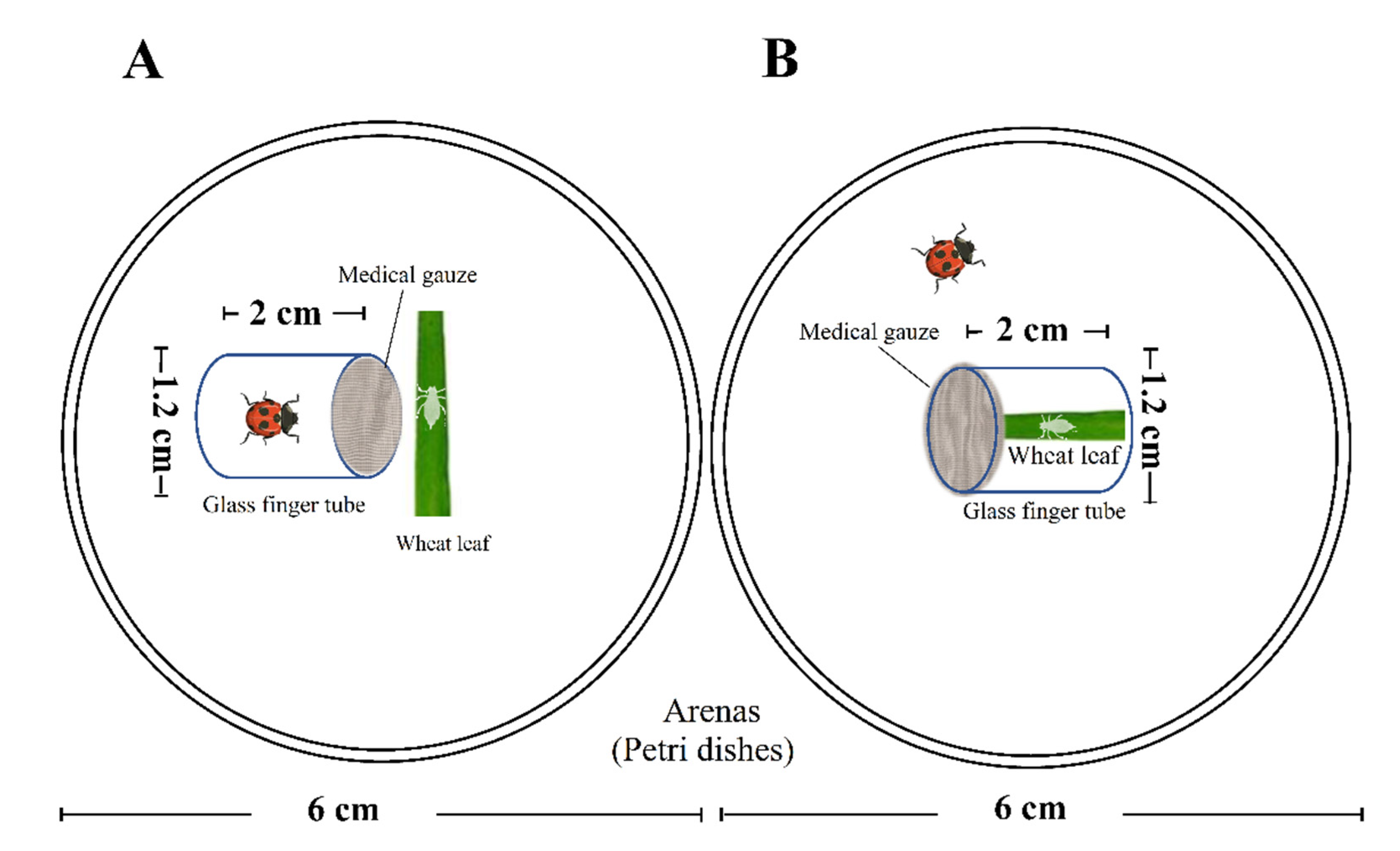
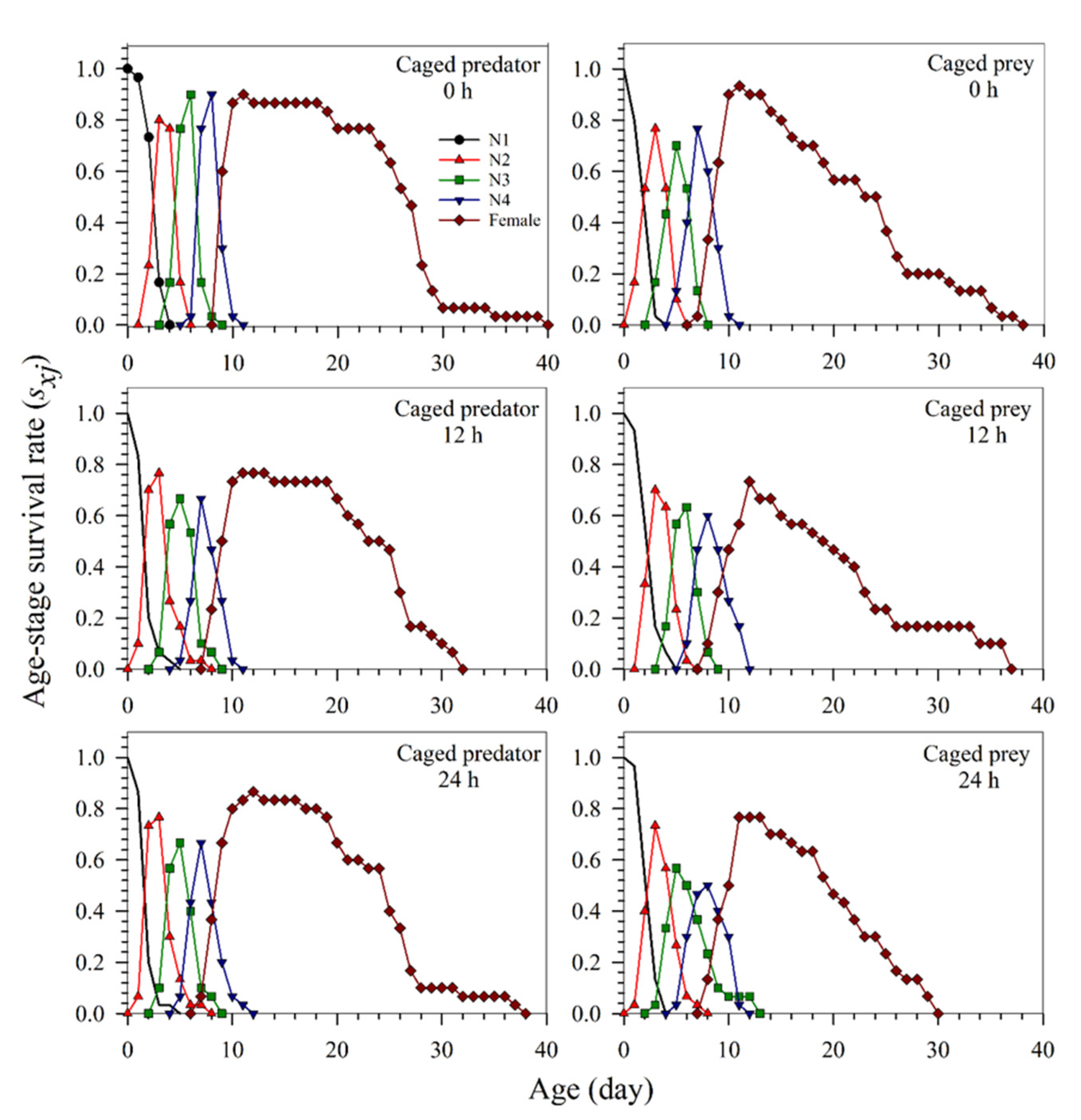
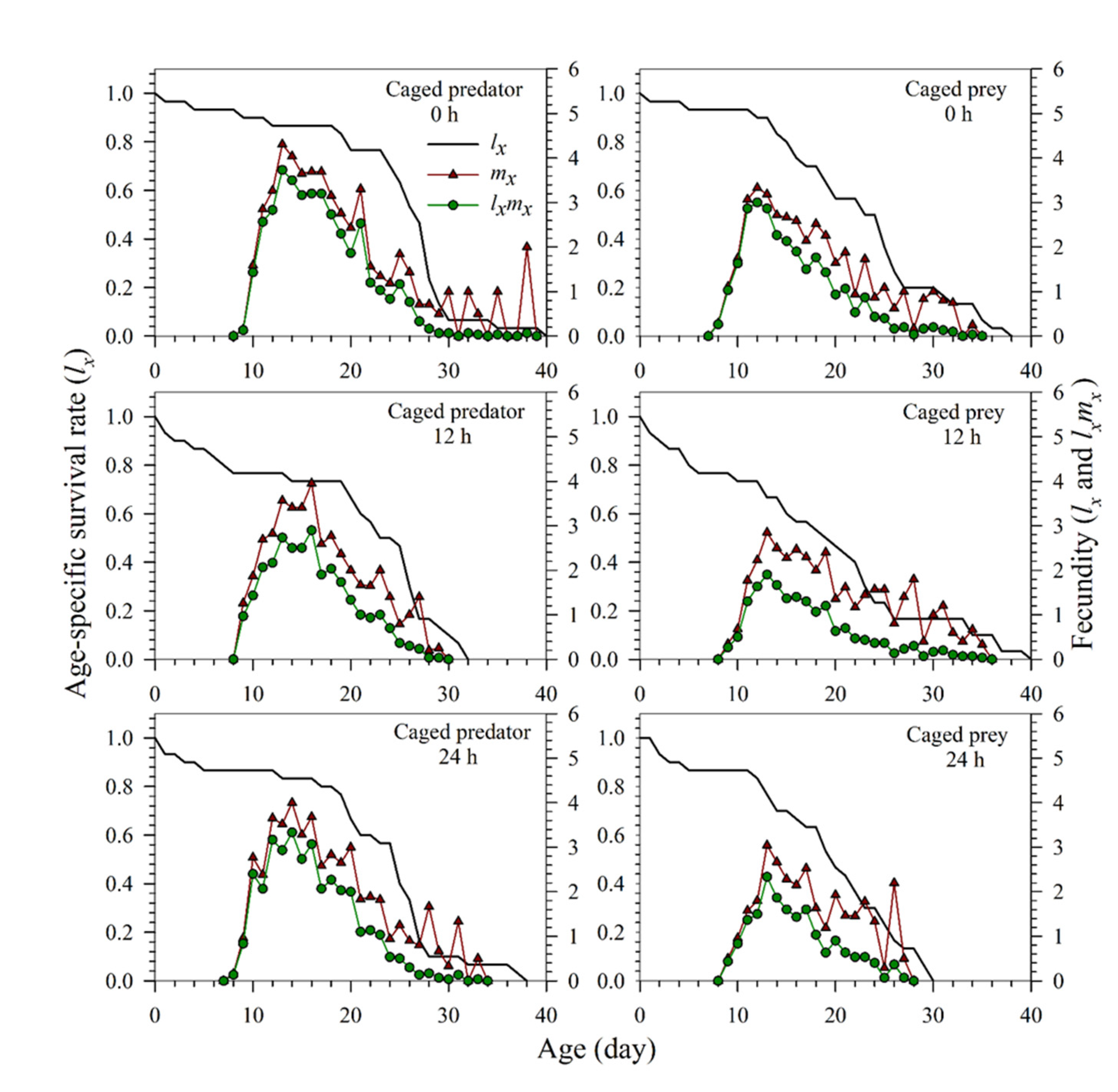

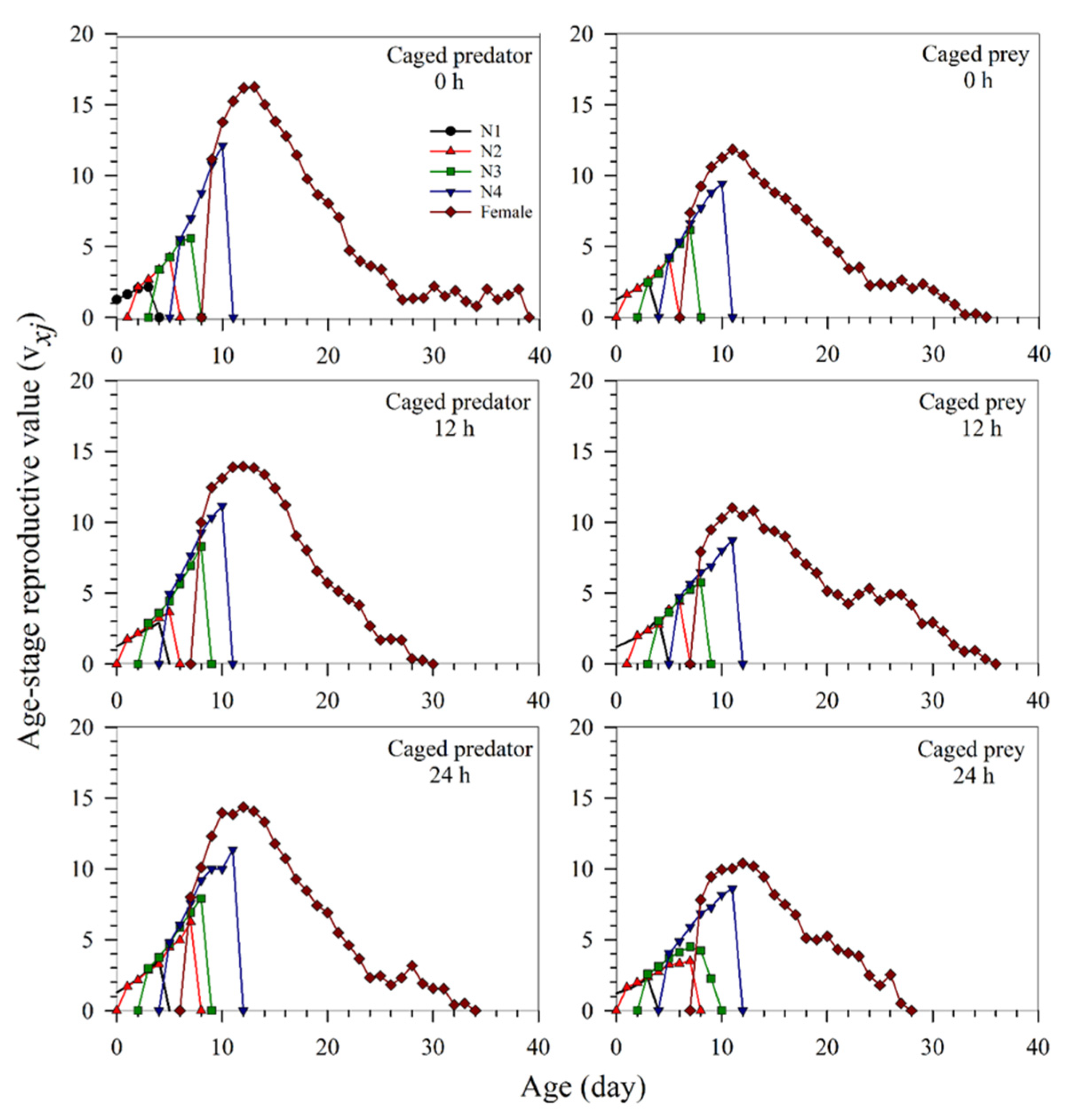
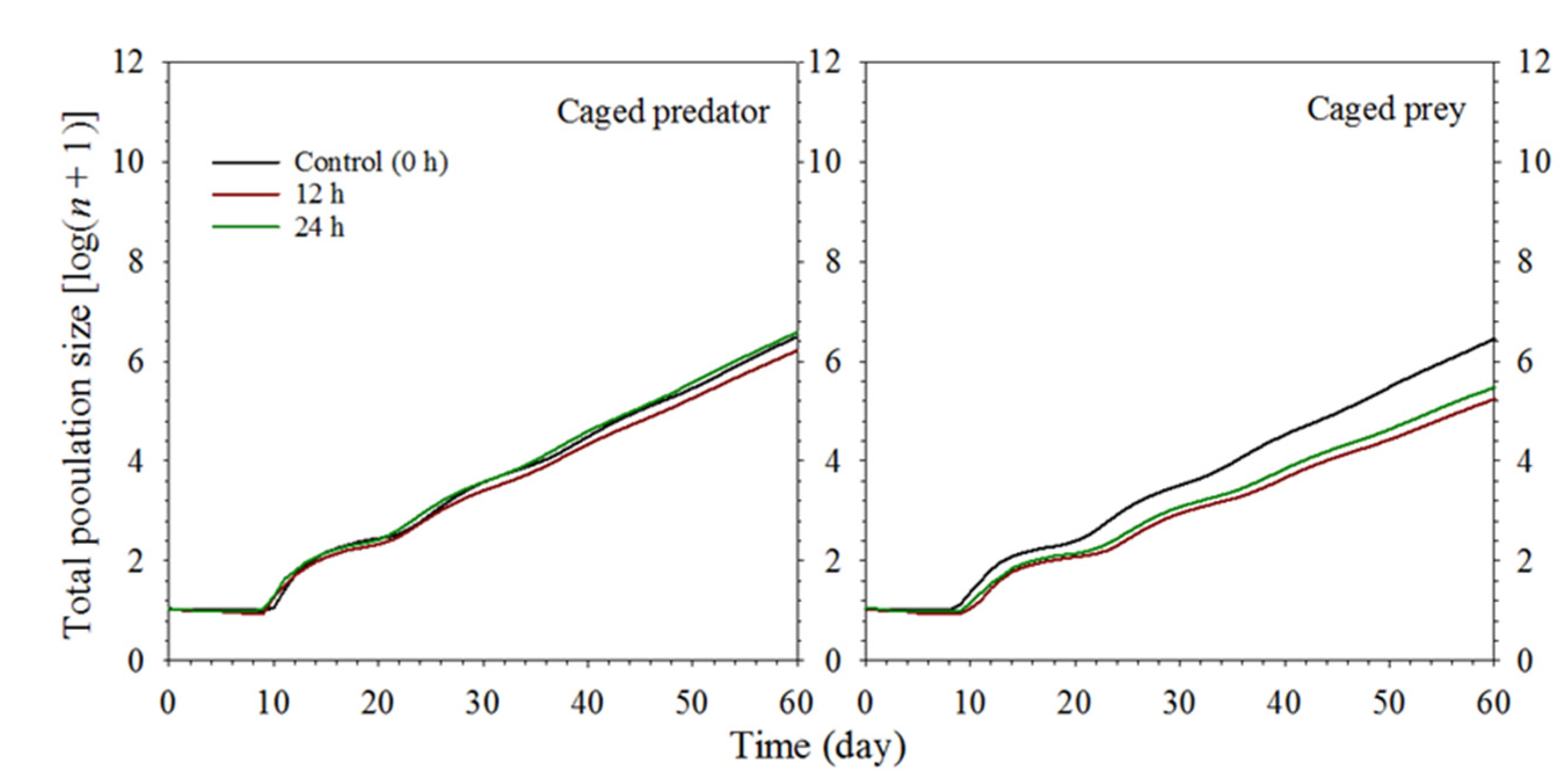
| Parameter and Equation | Definition |
|---|---|
| Adult pre-reproductive period: | The mean duration from the emergence of a female adult to its first reproduction. |
| Total pre-reproductive period: | The mean duration from the birth of a female individual to its first reproduction. A short TPRP denotes that the cohort can produce offspring earlier. |
| Age-stage survival rate: | The notation sxj represents the probability that a newly born individual will survive to age x and stage j, where n01 is the number of individuals used at the beginning of the life table study (i.e., the cohort size, and nxj is the number of surviving individuals at age x and stage j). The curves of sxj reveal the stage differentiation and the emergence of adults [38]. |
| Age-stage specific fecundity: fxj | The mean number of offspring produced by female adults at age x. The values fxj occurred at younger ages make a greater contribution to the intrinsic rate of increase and the finite rate of increase [32]. |
| Age-specific survival rate: | The probability that a newborn offspring will survive to age x (m is the number of stages). It is the pooled survival rate of all stages; therefore, it is the simplified version of sxj ignoring the stage differentiation [32]. |
| Age-specific fecundity: | The mean number of offspring produced by all surviving individuals at age x. If only a few individuals among all surviving ones can produce offspring at age x, there will be a significant gap between fxj and mx [32]. |
| Net reproductive rate: | The total number of offspring that an average individual (including females, and those died in the immature stage) can produce during its lifetime. Because R0 takes into consideration of the survival rate, it is usually less than the mean fecundity calculated based on female adults (i.e., R0 < F) [32]. |
| Intrinsic rate of increase: | The population growth rate as the time approaches infinity and the population reaches the stable age-stage distribution (SASD). The population size will increase at the rate of er per time unit. It is calculated by using the Euler–Lotka equation with age indexed from 0. The intrinsic rate is commonly used as an indicator of population fitness [32]. |
| The finite rate: | The population growth rate as the time approaches infinity and the population reaches the stable age-stage distribution. The population size will increase at the rate of λ per time unit. The finite rate of increase is also used as an indicator of population fitness [32]. |
| Mean generation time: | It is the time length that a population requires to increase to R0-fold of its size as the population growth rate reaches r and λ [32]. |
| Age-stage life expectancy: | The time that an individual of age x and stage j is expected to live. The notation is the probability that an individual of age x and stage j will survive to age i and stage y. It is calculated by assuming sxj = 1 [39]. Because the calculation of exj is not based on the assumption of SASD, it can be used to predict the longevity of individuals at age x and stage j. |
| Age-stage reproductive value: | The contribution of an individual of age x and stage j to the future population. Individuals survived to reproductive age (i.e., fxj > 0) usually have greater vxj (i.e., greater contribution) [40,41,42,43,44]. |
| Types of Predation Risk | Exposed Time (h) | N1 (d) | N2 (d) | N3 (d) | N4 (d) | Preadult (d) | Preadult Survival Rate |
|---|---|---|---|---|---|---|---|
| Caged predator | 0 | 2.89 ± 0.12 Aa | 2.11 ± 0.12 Aa | 2.15 ± 0.12 Aa | 2.26 ± 0.10 Aa | 9.37 ± 0.11 Aa | 0.90 ± 0.05 Aa |
| 12 | 2.22 ± 0.16 Bb | 2.32 ± 0.15 Aa | 2.39 ± 0.20 Aa | 2.26 ± 0.14 Aa | 9.09 ± 0.19 Bab | 0.77 ± 0.08 Aa | |
| 24 | 2.21 ± 0.14 Bb | 2.23 ± 0.13 Aa | 2.19 ± 0.11 Aa | 2.19 ± 0.12 Ba | 8.85 ± 0.23 Bb | 0.87 ± 0.06 Aa | |
| Caged prey | 0 | 2.31 ± 0.15 Bb | 2.17 ± 0.09 Aa | 2.04 ± 0.06 Ab | 2.39 ± 0.11 Aa | 8.96 ± 0.18 Ab | 0.93 ± 0.05 Aa |
| 12 | 2.88 ± 0.18 Aa | 2.33 ± 0.13 Aa | 2.22 ± 0.13 Aab | 2.68 ± 0.19 Aa | 10.05 ± 0.30 Aa | 0.73 ± 0.08 Ab | |
| 24 | 2.67 ± 0.15 Aab | 2.35 ± 0.11 Aa | 2.46 ± 0.17 Aa | 2.54 ± 0.12 Aa | 9.79 ± 0.25 Aa | 0.80 ± 0.07 Aab |
| Types of Predation Risk | Exposure Time (h) | APRP (d) | TPRP (d) | Adult Longevity (d) | Total Longevity (d) | Reproductive Days (d) | Fecundity | Winged Morphs to the Adults |
|---|---|---|---|---|---|---|---|---|
| Caged predator | 0 | 1.12 ± 0.14 Aa | 10.42 ± 0.18 Aa | 17.26 ± 1.03 Aa | 24.43 ± 1.52 Aa | 14.00 ± 0.71 Aa | 43.37 ± 3.05 Aa | 0.037 ± 0.037 Ab |
| 12 | 1.17 ± 0.12 Aa | 10.26 ± 0.25 Ba | 16.17 ± 0.95 Aa | 20.33 ± 1.81 Aa | 12.65 ± 0.85 Aa | 37.65 ± 3.11 Aa | 0.130 ± 0.071 Ab | |
| 24 | 1.08 ± 0.14 Aa | 9.88 ± 0.26 Ba | 16.12 ± 1.18 Aa | 21.97 ± 1.70 Aa | 13.24 ± 0.82 Aa | 39.46 ± 3.15 Aa | 0.269 ± 0.089 Aa | |
| Caged prey | 0 | 1.15 ± 0.13 Aa | 10.07 ± 0.27 Ab | 14.86 ± 1.36 Aa | 22.43 ± 1.60 Aa | 11.33 ± 1.03 Ba | 29.93 ± 2.80 Ba | 0.071 ± 0.049 Ab |
| 12 | 1.05 ± 0.14 Aa | 11.09 ± 0.29 Aa | 13.82 ± 1.79 Aa | 18.60 ± 2.09 Aa | 9.86 ± 1.40 Aa | 24.45 ± 3.73 Ba | 0.136 ± 0.075 Ab | |
| 24 | 1.27 ± 0.12 Aa | 10.95 ± 0.28 Aa | 12.21 ± 1.08 Ba | 18.87 ± 1.50 Aa | 9.73 ± 0.86 Ba | 22.67 ± 2.60 Ba | 0.250 ± 0.090 Aa |
| Types of Predation Risk | Exposed Time (h) | r † (d−1) | Λ ‡ (d−1) | R0§ (offspring) | T ¶ (d) |
|---|---|---|---|---|---|
| Caged predator | 0 | 0.2294 ± 0.0066 Aa | 1.2578 ± 0.0083 Aa | 39.04 ± 3.57 Aa | 15.96 ± 0.18 Aa |
| 12 | 0.2189 ± 0.0103 Aa | 1.2447 ± 0.0128 Aa | 28.87 ± 3.73 Ab | 15.33 ± 0.28 Aab | |
| 24 | 0.2335 ± 0.0083 Aa | 1.2630 ± 0.0104 Aa | 34.21 ± 3.62 Aab | 15.11 ± 0.22 Ab | |
| Caged prey | 0 | 0.2268 ± 0.0086 Aa | 1.2546 ± 0.0107 Aa | 27.94 ± 2.90 Ba | 14.67 ± 0.35 Bb |
| 12 | 0.1793 ± 0.0111 Bb | 1.1963 ± 0.0133 Bb | 17.94 ± 3.32 Bb | 16.01 ± 0.45 Aa | |
| 24 | 0.1878 ± 0.0109 Bb | 1.2067 ± 0.0131 Bb | 18.15 ± 2.61 Bb | 15.39 ± 0.37 Aab |
Publisher’s Note: MDPI stays neutral with regard to jurisdictional claims in published maps and institutional affiliations. |
© 2022 by the authors. Licensee MDPI, Basel, Switzerland. This article is an open access article distributed under the terms and conditions of the Creative Commons Attribution (CC BY) license (https://creativecommons.org/licenses/by/4.0/).
Share and Cite
Wang, L.; Atlihan, R.; Chai, R.; Dong, Y.; Luo, C.; Hu, Z. Assessment of Non-Consumptive Predation Risk of Coccinella septempunctata (Coleoptera: Coccinellidae) on the Population Growth of Sitobion miscanthi (Hemiptera: Aphididae). Insects 2022, 13, 524. https://doi.org/10.3390/insects13060524
Wang L, Atlihan R, Chai R, Dong Y, Luo C, Hu Z. Assessment of Non-Consumptive Predation Risk of Coccinella septempunctata (Coleoptera: Coccinellidae) on the Population Growth of Sitobion miscanthi (Hemiptera: Aphididae). Insects. 2022; 13(6):524. https://doi.org/10.3390/insects13060524
Chicago/Turabian StyleWang, Liping, Remzi Atlihan, Ruirui Chai, Yao Dong, Chen Luo, and Zuqing Hu. 2022. "Assessment of Non-Consumptive Predation Risk of Coccinella septempunctata (Coleoptera: Coccinellidae) on the Population Growth of Sitobion miscanthi (Hemiptera: Aphididae)" Insects 13, no. 6: 524. https://doi.org/10.3390/insects13060524
APA StyleWang, L., Atlihan, R., Chai, R., Dong, Y., Luo, C., & Hu, Z. (2022). Assessment of Non-Consumptive Predation Risk of Coccinella septempunctata (Coleoptera: Coccinellidae) on the Population Growth of Sitobion miscanthi (Hemiptera: Aphididae). Insects, 13(6), 524. https://doi.org/10.3390/insects13060524







